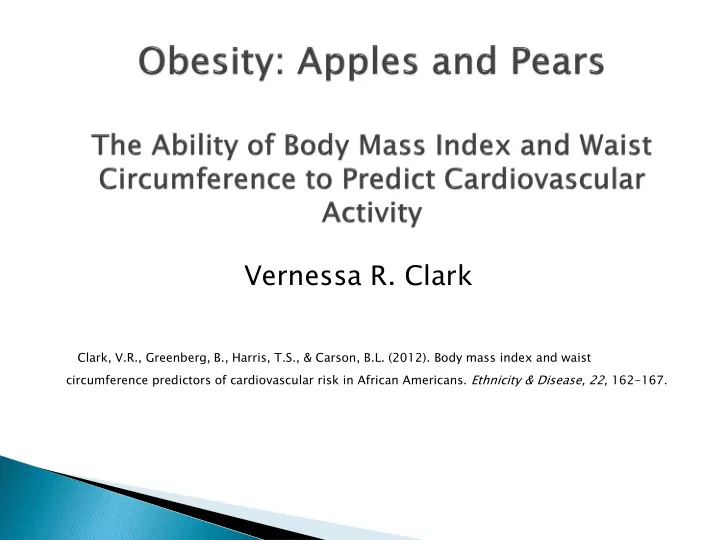

Vernessa R. Clark Clark, V.R., Greenberg, B., Harris, T.S., & Carson, B.L. (2012). Body mass index and waist circumference predictors of cardiovascular risk in African Americans. Ethnicity & Disease, 22, 162-167.
In 2010 - 2011: 35.7% of adults in the U.S were obese 33.3% of adults in the U.S were overweight (Centers for Disease Control and Prevention) 49.5% of African Americans were obese 34.3% of Whites were obese (Centers for Disease Control and Prevention)
In 2010 - 2011: 38.3% of African American men were obese 54% of African American women were obese (U.S. Department of Health and Human Services Office of Minority Health)
BMI is the traditional method of measuring obesity and has been associated with the onset of cardiovascular disease. However, a major weakness of BMI is that it does not distinguish between muscle and fat which leads to misclassification of certain people.
Another well documented method of assessing obesity is through the waist circumference. Waist circumference is the measurement of abdominal fat.
Clark and Hill (2009) examined the effects of body mass index on cardiovascular reactivity to a racial stressor in 54 African American college students. We found that as expected, obese men had greater cardiovascular reactivity to the racial stressor than their thinner counterparts.
Brenner, Tepylo, Eny, Cahill, and El-Sohemy (2010) investigated the ability of waist circumference and BMI to predict cholesterol concentrations. 1181 men and women from Canada They found that waist circumference significantly predicted cholesterol for both men and women.
Other researchers have reported that BMI and waist circumference together, is the best predictor of the future onset of cardiovascular illnesses. For example, Sarno and Monteiro (2007) studied the effects of BMI and waist circumference on the occurrence of hypertension. 1584 men and women from Brazil The authors found that the combination of BMI and waist circumference increased the prevalence for hypertension.
The purpose of the present study was to determine which measure of obesity (WC or BMI) is a better predictor of cardiovascular activity. It was hypothesized that: Waist circumference alone would be a significant predictor of cardiovascular activity; BMI alone would be a significant predictor of cardiovascular activity; BMI and waist circumference together would be the best predictor of cardiovascular activity.
One hundred and five African American college students (21 males, 84 females), between the ages of 18–27, participated in this study. screened for cardiovascular disorders or medications that would interfere with cardiovascular functioning U.S. citizens
A Hypertension Diagnostics cardiovascular profiling instrument was used to assess: heart rate systolic and diastolic blood pressure stroke volume cardiac output
A racially noxious scene on a digital video disc (DVD) was used as the stressor. The scene showed the horrific conditions endured by Africans as they were being transported to America for slavery.
Cardiovascular measurements were taken: prior to each scene (pre-stressor period) during the scene (stressor period) while the participants recovered from the scene (recovery period).
Calculated from height and weight Categories of BMI: N underweight (BMI under 18.5 kg/m 2 ) 4 normal weight (BMI of 18.5 -24.9 kg/m 2 ) 50 overweight (BMI of 25 -29.9 kg/m 2 ) 23 obese (BMI of 30 kg/m 2 or greater) 28
For me or men: N below 94 cm was classified as normal risk 17 94 cm -101cm was classified as an increased risk 2 102 cm or above was classified as a substantial risk 2 For w or wome omen: below 80 cm was classified as normal risk 25 80 cm - 87cm was classified as an increased risk 14 88 cm or above was classified as a substantial risk 45
Multiple Regression: Our first hypothesis suggested that BMI alone would be a significant predictor of cardiovascular reactivity. [Supported] BMI predicted: Systolic blood pressure during all 3 periods + Stroke volume during all 3 periods + Cardiac output during all 3 periods +
Beta SE t p _____________________________________________________________________________________ Systolic Blood Pressure Pre-stressor .348 .160 3.73 .000 Systolic Blood Pressure Stressor .402 .156 4.37 .000 Systolic Blood Pressure Recovery .332 .154 3.49 .001 Stroke Volume Pre-stressor .483 .210 5.58 .000 Stroke Volume Stressor .464 .202 5.21 .000 Stroke Volume Recovery .465 .205 5.20 .000 Cardiac Output Pre-stressor .750 .008 11.45 .000 Cardiac Output Stressor .754 .008 11.43 .000 Cardiac Output Recovery .762 .008 11.64 .000 * These results were obtained when BMI was entered into the regression equation alone.
Our second hypothesis stated that waist circumference alone would significantly predict cardiovascular reactivity. [Supported] Waist Circumference predicted: Systolic blood pressure during all 3 periods. + Stroke volume during all 3 periods + Cardiac output during all 3 periods +
Beta SE t p ________________________________________________________________ Systolic Blood Pressure Pre-stressor .379 .275 2.34 .021 Systolic Blood Pressure Stressor .340 .268 2.15 .034 Systolic Blood Pressure Recovery .413 .262 2.55 .012 Stroke Volume Pre-stressor .498 .366 3.29 .001 Stroke Volume Stressor .502 .349 3.24 .002 Stroke Volume Recovery .464 .349 3.03 .003 Cardiac Output Pre-stressor .633 .015 5.61 .000 Cardiac Output Stressor .742 .014 6.50 .000 Cardiac Output Recovery .761 .014 6.85 .000
Our third hypothesis stated that BMI and waist circumference toge together would be the best predictor of cardiovascular reactivity. BMI p I pred edicted ed: Systolic blood pressure during all 3 periods + Stroke volume during all 3 periods + Cardiac output during all 3 periods + Waist Ci Circumfer eren ence e pred edicted ed: nothing
Research shows that African Americans have less abdominal fat than Whites (Sumner et al., 2008; Katzmarzyk, et al., 2011). To this end, waist circumference thresholds standardized on Whites may not be an accurate predictor of cardiovascular disease in African Americans.
Recommend
More recommend